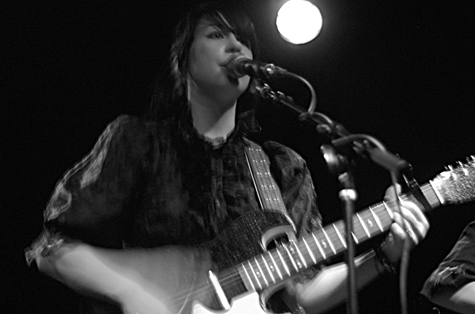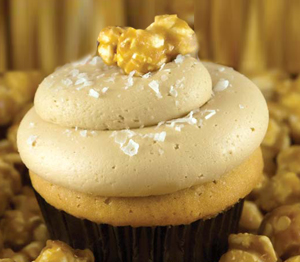 Downtown Sacramento is about to get a whole lot sweeter when Icing on the Cupcake’s new store opens up at 1121 Alhambra Boulevard (in between Jamba Juice and La Fiesta Taqueria to give you a general idea). Icing already has two stores in the region, one in Rocklin and one in Folsom and on Oct. 16, 2010 they’ll celebrate the grand opening of their first downtown spot. This month their special flavor is caramel corn, and if you take just two seconds to navigate to their website, www.icingonthecupcake.com, we’re pretty sure your mouth will be watering at the sight of this salty and sweet delectable treat. “We took rich vanilla butter cake, topped it with a creamy caramel butter cream frosting, and finished it off with fleur de sel and a piece of caramel corn,” says the description. Mmm, sign us up for a dozen! Also this month, Icing on the Cupcake is donating one dollar from every “Pinkdelicious” cupcake (Icing’s “signature cupcake”) sold through Oct. 31, 2010 to CureBreastCancer.org. Their cupcakes are sweet and so are their hearts!
Downtown Sacramento is about to get a whole lot sweeter when Icing on the Cupcake’s new store opens up at 1121 Alhambra Boulevard (in between Jamba Juice and La Fiesta Taqueria to give you a general idea). Icing already has two stores in the region, one in Rocklin and one in Folsom and on Oct. 16, 2010 they’ll celebrate the grand opening of their first downtown spot. This month their special flavor is caramel corn, and if you take just two seconds to navigate to their website, www.icingonthecupcake.com, we’re pretty sure your mouth will be watering at the sight of this salty and sweet delectable treat. “We took rich vanilla butter cake, topped it with a creamy caramel butter cream frosting, and finished it off with fleur de sel and a piece of caramel corn,” says the description. Mmm, sign us up for a dozen! Also this month, Icing on the Cupcake is donating one dollar from every “Pinkdelicious” cupcake (Icing’s “signature cupcake”) sold through Oct. 31, 2010 to CureBreastCancer.org. Their cupcakes are sweet and so are their hearts!
Tag Archives: Sacramento
Icing on the Cupcake’s new Sacramento Location
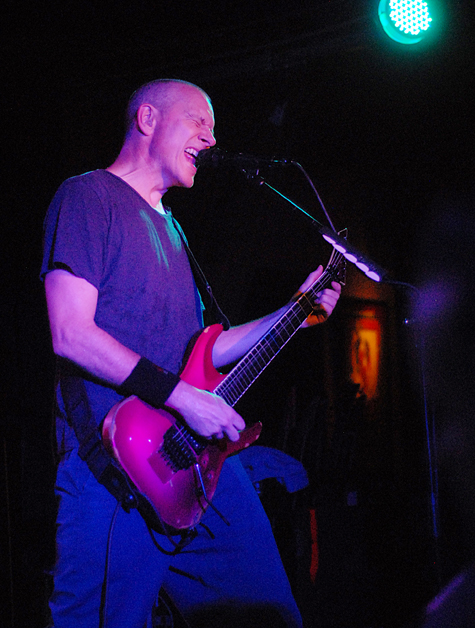
Alive and Kicking
Helmet, Bison B.C., Will Haven
Harlow’s – Sacramento, Calif. – Wednesday, Sept. 8, 2010
Words by Bobby S. Gulshan
As promised on the flyer, Grady Avenell has indeed returned to vocals, and the local faithful flocked to Harlow’s for Will Haven. Some call it metalcore, or post-hardcore, but Will Haven’s particular brand of bombast proves too elusive for quick categorization. Opening with “I‘ve Seen My Fate,” the dual guitar attack combined with keyboard atmospheres and driving rhythmic breakdowns conspired to create a steady sonic barrage. Avenell’s searing screams hammered the point deeper. With his back often to the audience, Avenell and the rest of Will Haven tore through their set with high-energy physicality, head banging in lockstep with one another. Songs such as “Helena” and “Carpe Diem” displayed the straightforward appeal of Will Haven’s approach.


Their music relies on power and heaviness coupled with a driving rhythmic intensity. Tonally, the riffs were almost monochromatic, with guitarist Jeff Irwin providing occasional hints of color with high-pitched staccato runs. Closing with “Stick up Kid,“ the band displayed its full physical force, finishing up a blistering set of six songs that left the hometown crowd hungry for more.

Hailing from the Great White North, Bison B.C. took the stage in the second slot. On tour with Helmet in support of their new LP, Dark Ages, the Canadian metal outfit added classic thrash-style riffs to a night of hardcore punishment. The guys themselves look like modern primitives, as if they wandered out of the same deep forest as the mythical Wendigo, which they reference in one of their more epic tunes. James Farwell and Dan And provide guitars and vocals, one singing with a characteristic death metal growl, and the other providing a cleaner vocal on more melodic sections. As drummer Brad McKinnon told me after the show, “When I first heard Dio all those years ago, it hit a place, and it’s been metal ever since.” Indeed. Bison B.C. fills their sonic space with complex riffs and blistering solos, as well as hardcore breakdowns. “Slow Hand of Death” displayed Bison’s ability to combine thrashing riffs with off-kilter time signatures, moving seamlessly into a galloping melodic section, and then returning to churning extended breakdowns. “Wendigo Pt.1” featured both guitarists locked in harmonies that evoked one part Slayer, one part Iron Maiden. However, the development of the songs–particularly the ability to transition from a blast beat to an extended break with ease–is signature Bison. The Harlow’s audience seemed a bit unprepared for this metal onslaught, but showed their appreciation nonetheless.
Turning 50 doesn’t seem to have slowed Page Hamilton. By the time Helmet took the stage, Harlow’s was packed and surging, and the seemingly ageless Hamilton did not disappoint. He told the audience that he was supposed to be on a juice diet, and then promptly took a swig from his Corona. Hamilton played to the audience, constantly engaging them with wit and charm. At one point between songs, Hamilton brought up the subject of football, taking a quick shot at the Pittsburgh Steelers by pointing out that “their quarterback is a rapist.”
Helmet’s classic album Meantime was released in 1992. While new tunes still bear the signature of Hamilton’s “glory days,” nothing sounds dated. Helmet has mastered extended breakdowns, utilizing various downtuned and detuned setups to create deep, heavy tones. The almost mechanical rhythms are persistent and stark, while the start-and-stop nature of the riffs keep bodies moving with an internal groove. Hamilton’s clear vocal melodies are somewhat refreshing in an age where the growl has become the lingua franca of hardcore and metal. Yet the riffs and breakdowns are as hard as anything out there. Old tracks like “Ironhead” and “Role Model” blended perfectly with new material, like the title track of the new album, “Seeing Eye Dog” and “So Long.” The show, of course, would not be complete without a performance of “Unsung,” which jolted the crowd into a frenzied sing-along with Hamilton. The back and forth with the audience continued during the encore when Hamilton asked the audience to pick three songs. “Black Top,” “In the Meantime” and “I Know” finished off the show, as requested by the fans. For a band that hasn’t toured in some time, Helmet and Hamilton have not lost a step, and all indications point to a long and hard-hitting future for the hardcore legend.
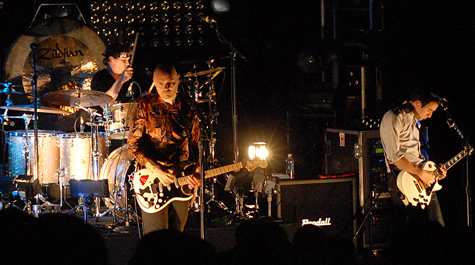
Electrified!
Smashing Pumpkins
Crest Theatre, Sacramento, Calif.
Monday, Sept. 6, 2010
At 7:30 p.m. the corner of 10th and K streets was littered with hundreds of Smashing Pumpkins fans waiting in line to see Billy Corgan and crew in one of Sacramento’s most beautiful venues, the historic Crest Theatre. As fans poured into the building (and especially into the beer garden), Chicago’s Bad City attempted to get the crowd ignited with their ‘80s hair-metal influenced tunes. SPIN.com called them “a modern day Whitesnake,” and I’d say that’s a pretty spot-on description.
At 9:01 p.m. the lights dimmed and the crowd roared as Corgan and his current lineup, which includes 20-year-old drumming prodigy Mike Byrne, lead guitarist Jeff Schroeder and bassist Nicole Fiorentino, took the stage. The first song they dove into was “Astral Planes,” a newer song from Teargarden by Kaleidyscope, where Corgan sings “Everyone gather, warm your soul,” on top of a grungy, slightly Fuguzi-esque guitar riff. Indeed, everyone had gathered; and rest assured our souls were warming, as did the energy in the room. The song “1979” off the nine-times-platinum album Mellon Collie and the Infinite Sadness had the crowd reciting every lyric back at Corgan, as did songs like “Bullet with Butterfly Wings,” and “Tonight, Tonight,” which sounded fantastic despite the apparent lack of a string section like on the original recording. In the same manner, the song “Eye,” released on the Lost Highway soundtrack in 1996, which is very electronica, translated great into this guitar-driven performance with live drums. Speaking of drums, it needs to be noted that Byrne was an absolute beast all night and at one point soloed for a solid four minutes onstage by himself and left any drummers in the crowd wanting to quit immediately.
At one point about midway through the show, an acoustic guitar was brought out for a change of pace. Corgan even played ukulele on one song. With the change in pace came the first real crowd interaction on Corgan’s behalf. He mentioned how in his hotel room there was a copy of Sactown Magazine. “Sactown!” Corgan yelled. “Isn’t that what they call it?” He poked fun at the term “Sactown” a little more and muttered that maybe it wasn’t a good term to use if our town was looking to attract tourists. People laughed. He also thanked those in the front row who were smoking pot. People laughed more. It was refreshing to see Corgan, now 43 years old, having a little fun with the crowd. After an epic encore, the band left the stage to screeching feedback, waving to the crowd while throwing picks and drumsticks along the way.
At 11 p.m. the crowd was pouring out of the theater, electrified. Every one of us knew we had witnessed something special, something to brag about. It’s not every day Billy Corgan is in town.
Shake Your Moneymaker
Dum Dum Girls, Crocodiles
Tuesday, June 29, 2010
Blue Lamp – Sacramento
Words & Photo Vincent Girimonte
Dum Dum Girls maestro Dee Dee stands tall over an attentive Blue Lamp crowd eager for the “buzz show of the summer” last Tuesday, hammering away on distortion and crooning about whatever people were crooning about in 1960s Western Europe–in the movies, that is.
Niche doesn’t begin to describe this band’s appeal; the Sub Pop girls in frayed lace, leggings, and sporting beautifully chopped bangs have that production-line mannequin sound that reeks of art-school irony, but continues to resonate nonetheless.
One can’t help but wonder what shape Dum Dum Girls, who headlined Brian McKenna’s bill after local act Chelsea Wolfe and San Diego’s Crocodiles, would have taken if Dee Dee’s original bedroom project were to explore something other than the four hot-chick dynamic, and whether it would have proven more interesting.
Last Tuesday’s Blue Lamp incarnation was scintillating for its lustiness–legs, thighs, lipstick; they all nailed it–and Sandra Vu beat on drums like some steamy Amazonian coxswain. The sound, however, while pulling heavily from ‘60s pop, also seemed to play on our current infatuation with the washed-out and feminine. Lines were sometimes blurred with Vivian Girls and former HoZac Record mates The Girls at Dawn–regardless of who was there first (and despite their leggings), Dum Dum Girls is drawing from a familiar well.
This gripe doesn’t necessarily speak to Dee Dee’s (aka Kristin Gundred) ability, however. She blew a few big notes in a sort of Pat Benatar homage, shimmying just a little to the rhythm with a menacing scowl. Her vocals meshed nicely atop the pervasive lo-fi guitars with bassist Bambi and fellow guitarist Jules, both statuesque in the literal sense, playing foils to Dee Dee’s subtle charm. In short, there was nothing wrong with the snappy set, but nothing terribly distinguishing about it either.
I Will Be, Dum Dum Girls’ 2010 release, was co-produced by Richard Gottehrer, a pop veteran who wrote such classics as “My Boyfriend’s Back” and “I Want Candy.” An old-school catchiness permeates through I Will Be, re-imagining and alluding to a time when crisp numbers reigned with Wall of Sound production. Not everyone was buying it at the Blue Lamp, though, or maybe we’ve just become tired of it for the second time around.
Patrons spilled out of the venue on Alhambra and N for fresh air between sets–Blue Lamp regulars claim it as Sacramento’s muggiest venue, which of course is amplified by June-coming-on-July heat. Ordinarily, such a spot deems tight leather jackets a nuisance not worth the classic motif, but strutting and strapped in to his Italian diaper was Crocodiles singer Brandon Welchez, quite committed to the whole “I’m fucking awesome” thing, propped up by the fact that he sounded pretty fucking awesome. New single “Sleep Forever” is a soaring hip-thruster, and tracks from their decidedly average 2009 Summer of Hate album seemed well suited for all 10 cubic feet (roughly) of the Blue Lamp. And even if you weren’t buying it, with the Crocs or the Dum Dums, you had to admit: they were selling it pretty hard.
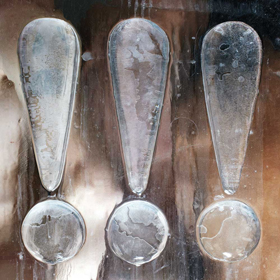
Sound Off!
Nic Offer of !!! Talks About The Weather
Creative people come in all kinds. The creative environment that works for you may not work for me. Maybe you need seclusion, a familiar place, peace and quiet, or maybe you require a Scarface-size mountain of coke and a room full of half-dressed, semi-conscious admirers strewn about the floor to craft your magnum opus. Hey, whatever works, right? For their latest album, New York by way of Sacramento band !!! literally traversed the globe, committing its latest batch of songs to tape. Strange Weather, Isn’t It?, the band’s fourth album, was recorded in New York, Berlin and even right here at the Hangar in Sacramento. Frontman Nic Offer admits that though it may sound exciting this probably isn’t the most economic way to work.
“It’s not always the best way to do things, but it’s kind of the way we ended up,” he says. “We’re living in four or five different towns with the majority of people in New York. We can’t just make everyone come to New York, so we pick some place to meet up.”
Location-jumping in order to get work done isn’t new for the group. Offer says the band has met up to practice in a variety of different places, such as Seattle, even though no one in the band resides there.
Berlin, however far off it may seem from the River City or even the Big Apple, was not an entirely random choice. The band’s now-former bassist Tyler Pope called the German capital home. Even more so, Offer says that the decision to record in Berlin was a creative one. In !!!’s most recent bio, the frontman is quoted as saying “Everyone’s got a Berlin record in them, and I guess we just wanted to see what ours would sound like.” However, in our interview, he mentions that the remark was meant to be taken lightheartedly.
“It was really just a joke,” he says. “Anyone can just go there and do it. Everyone’s got a Sacramento record in them, you know?”
Jokes aside, Offer explains that recording in Berlin did have a certain draw to it.
“There’s just that whole mystique of a Berlin record,” he goes on to say. “It was just an experiment to see what we would make, to see if it would affect the record. It was just an experiment, which I think is important when you’re writing, to just try different things.”
If hopping continents to record the album weren’t enough, !!! also underwent a series of lineup changes around the time Strange Weather… was written and recorded. Pope exited while the album was being recorded; meanwhile, John Pugh and Justin Vandervolgen departed before writing began (compounding the tragic death of drummer Jerry Fuchs in November 2009). All of these changes mean a very different !!!, and it shows in the music. In the following interview, Offer talks about his creative process, recording Strange Weather…, hanging out in Berlin and his signature dance move.
Are you guys into a lot of the Krautrock stuff?
When we first started the band, it was right when we were getting into Can, and we heard how they would jam for 14 hours a day in some castle in Germany, and that just seemed completely unreal to us. Now, with the change of technology, we can jam for hours. We couldn’t afford to buy that much tape and hire somebody for that, but now with computers, you can jam as long as you can stay awake and not have to stop it. And there we were in Germany with the opportunity. It was like living the dream, to be there and have nothing else to do but jam.
It’s interesting to hear you say that you did a lot of jamming when writing this record, because the album is very tight. There is almost a pop-y feel to it. Did that come out of the jamming process?
There are songs on there that are from hour-long jams that we could have [written] a whole other song out of. It’s like we would jam, record it all, then make loops of the best bits, put them next to each other and listen to them together to see where people got the most excited. Lots of things we had to let go come back in later songs down the line or something. It’s a big process of narrowing down that got it down to something so pop.
Was there an inclination to make more sprawling songs? When did you feel it going in a tighter direction?
It was really a conversation I had with my friend Margo. She was complaining about how our songs were too long and jam-y. At the time, the conversation kind of hurt my feelings a bit, but I just kept hearing her voice in my head as we finished the record. If anything, you just want to make something your friends like. If your friends are listening to it, not just because they’re your friends, but because they like it, then that’s a really high compliment. That’s something we’re always shooting for. We’re shooting to make Margo happy.
So she’s sort of like a member of the band?
Yeah, she’s our executive producer.
Was that something you were feeling at all–that your songs were too long, and when she said it, it kind of backed up what you were thinking?
No, actually, that was the thing. When you get criticism, sometimes it’s like you kind of did already know it and didn’t admit it to yourself. You’ll hear it and say, “Actually, that is kind of right.” When you don’t agree with it, it’s good because it makes you work harder to get your point across. It’s like, “That’s not working for people. This is exciting me. How can I make what excites me work for other people?” It just makes you hone it better. That’s one of the really good things about criticism. My advice to any musician would be to learn how to take criticism and find someone who can criticize you well and that you trust. That’s important too, because some people just talk out of their ass, and you don’t need to listen to them. To have a really good friend who you know you can play something for and they’ll tell you the truth is really helpful as a songwriter.
When you were recording out in Berlin, did you spend a lot of time in the clubs?
We tried to as much as we could. You have to keep it together and not get too wasted so you can do something worthwhile the next day. We were going out as much as we could, really–or some of us would. Some of us went out more than others.
Did what you hear in the clubs play into what you were jamming on in the studio?
Yeah, for sure. It’s a really good way to work, when you’re working all day, and then you go out to the clubs and hear the kind of things that you were working on and how they’re working live, and how they’re affecting people. It makes you pay attention to things differently.
During the making of this record, you had a few band members leave–two before and one during–how did that affect how you guys worked?
It was kind of something we rolled with. It was an unlucky break when Justin left, because he produced the last record. He really played referee between a lot of our fights and really understood us. He was in the band, so he understood where we were coming from and where we needed to be pushed. He had a technical head that a lot of us didn’t, but we just brought in another producer. You try to use what you’re given to work with. We tried to use the advantages of having a fresh producer to get a different sound. That’s all you can do. You make the record from where you’re at instead of lamenting where you were.
Did you enjoy having someone outside the group, Eric Broucek, produce this album?
Yeah. Sometimes it was a bit difficult, and sometimes it felt like he was a little too outside the group and coming from a different perspective, but listening to the record now, after all the fights are done, I think he did some really good stuff on it.
Was there combat between you and Eric?
Yeah, but there’s push and pull between everyone. It’s like he just becomes a member of the band eventually. He’s just becomes another person to fight with [laughs].
Is the fighting an important part of your creative process?
Uh…yeah. I wish it wasn’t. I don’t want to say that it’s the ultimate creative tool and that all bands should fight each other to make a record, but I think if you can learn from the fighting and learn how to fight better so you’re not hurting each other’s feelings and saying what needs to be said. If you’re letting the record be made, and you’re not criticizing it, and you’re not saying what needs to be said, the things you’re afraid to say to your band mates, they’re going to read in the press anyway, so you might as well say them now. I do believe fighting can be a powerful creative tool.
Getting ready for this interview, I saw a lot of videos of you on YouTube just losing it on stage. Do you have a go-to dance move? I noticed the one where you have your arms down at your sides and you kind of shimmy, I guess.
Yeah, I’ll have a lot of people come up to me after the show and say that they can do my dance, and they’ll bust into that one. That seems to be the one that people have glommed onto the most. People from all over the place, unconnected, would call it “The Penguin.” That works for me. That’s cool.
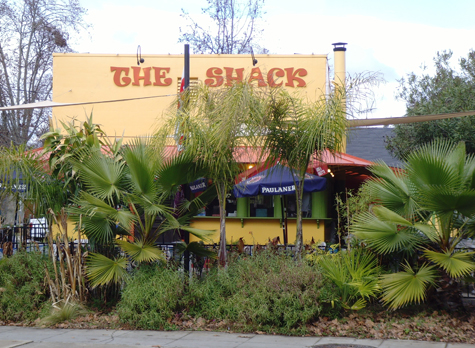
Love Shack
The Shack
5201 Folsom Boulevard Sacramento, CA
The first step in acquiring a new restaurant location is to look at what was left from the previous owner and decide whether or not it is of use. The Shack, located on 52nd Street and Folsom Boulevard, made several executive decisions that won my heart and tummy over, but electing to paint over the word “Sub” on the sign to give the establishment its desired name made me an instant fan. Sure, there’s a noticeable space between “The” and “Shack,” but it’s got low-budget charm.
Not yet a year old, The Shack sits across the street from SoCal Tavern in East Sacramento. The exotic overgrown shrubbery shields patrons from scorching sunrays, but the sandwich joint is still easy to spot with its bright orange, yellow and lime green color scheme. Patrons have the option of either the indoor diner and wooden booth tavern-style seating or the wraparound patio with an assortment of umbrella-guarded tables, wicker chairs and picnic benches. Do not let the name “Shack” fool you; it’s a quaint venue, but not a shoebox like, say, Jim Denny’s. I took to the patio, finding a comfortable table without much dilemma during the lunch rush.
I ordered a 1/3-pound. Shack Burger, absorbing the venue into my short list of local business burgers to try, adding cheddar for 75 cents. Mushrooms, jalapenos and grilled onions are also available extras for 75 cents apiece, while avocado, bacon and pastrami are all $1.50–industry standard. The Shack did not appear to have a signature sandwich as the menu sticks to the basics: BLT, patty melt, club, Philly-style steak sandwich and, of course, the Reuben. The burger came pre-loaded with lettuce, tomato and onions, so do not assume privilege to apply as needed, with a fat pickle slice and a side of fries. The Shack makes its burgers medium to perfection, retaining all the juicy bites that are greasy enough to dribble a little down your chin, but not clog an artery on site.
The Shack rises above the norm with its beer selection. Of the 13 beers on tap, only Pabst Blue Ribbon and Stella Artois were not of the craft brew ilk. This spot is listed as one of the admired and patronized spots of the Hop Heads of Sacramento Beer Lovers Union–if this crew is digging your brews, then you’re clearly not fucking around.
I paired my burger with a Leffe Blonde, one of my all-time Belgian favorites. Buried at the bottom of the list for domestic bottles were Budweiser, Bud Light and Coors, while the libations list spanned three pages that categorized the extensive list to include German, Belgian and Dopplebocks, among others. Had I not been on assignment, I’d have indulged in a bottle of Chimay to wash down my hearty burger and finished the Sacramento Bee’s crossword or marginally challenged the New York Times’.
Deadlines aside, the only further drawback to The Shack is that its off-the-grid location made it a safe haven for young yuppies in training. It bemused and amused me equally to be in their company, eavesdropping on 4th of July barbecue plans and regaled stories of secretly pounding fifths of vodka at River Cats games–how rad is alcohol-poisoning, bro?
I’ll chalk this setback up to the Friday lunch crowd on an impending holiday weekend. The Shack is still a great place to patron. The sliced pickle that came with my burger was huge and crunchy. Tuesdays are beer tasting nights; week one, for example, is Belgian beers. And with the brunch scene in Midtown already ablaze, I might sneak away to The Shack one weekend for a Huevos Del Shacko (two eggs, corn tortillas, ham and house-made ranchero sauce, served with potatoes) and $10 liters of mimosa.

Hot Heat, Bruleed Treat
Cafe Rolle
5357 H Street – Sacramento, Calif.
Every year when summer finally shines fully upon Sacramento, residents are shocked at the heat waves splashing over our city. But frankly, summer is synonymous with heat. Perhaps that’s why so many choose to live here. With heat, the barbecue gets used, the sprinkler gets run through, many visits occur to the park and the movie theater, we make sure our friends with boats take us out on the river. It’s a beautiful thing and we love summer.
With all of the wonderful aspect of life that summer features, creamy cold desserts deserve a special mention. Although ice cream, frozen yogurt, gelato, sorbet and blended drinks are common after-suppertries on summer evenings, crème brûlée is a perfectly creamy and cool treat that only a foodie fool could forget.
Like with any interesting person, cracking through the exterior shell (in this case, the hardened, caramelized sugar seal of the trop chic dessert) to get to the treasure beyond is part of the fun. With the coveted Sacramento French Film Festival currently screening, what better time to revisit such a simply sophisticated French dessert?
Crème brûlée has been found on nearly every restaurant menu at one point or another in the last few years and is as commonly known as other French dairy like Brie or chevre cheeses. It’s exotic, foreign and always met with eating intrigue and enthusiasm, yet very pure and simple.
Cream, egg yolks, vanilla bean (as opposed to extract), sugar and flame are plain ingredients that are met with great care, technique, timing and temperature to properly prepare crème custard to be burnt for your pleasure.
With vanilla being the only true flavoring, crème brûlée’s “wow” factor isn’t the taste–it’s the texture. The juxtaposition between rigid, glass-like, burnt sugar and the purest, weightless, cloud-like velvety vanilla cream creates the fabulous flavor.
On a recent lovely drive east down H Street from Midtown, I headed toward Café Rolle for an authentic and reasonably priced cool crème brûlée on a hot summer evening.
With the establishment closing at 7:30 p.m., I managed to grab a corner table before the quaint café closed.
Always on-site and taking the utmost pride in his work (tres francais), server/manager Rafik Rabehi described the desserts du jour when I requested a menu. The crème brûlée of the day was baked with blackberries and chilled before being sugared and torched.
Sold! And it was everything I had hoped it would be. For only $5 (4.03 euros at current exchange), my crème brûlée was freshly flambéed and served in an individual ramekin the diameter of a softball, with fresh blackberries and the best flavor and texture.
Oh hot summer heat and cool treats! Je vous adore!
After my cool crème brûlée encounter, I walked away, grinning like a fool, as if I just met my next ex-boyfriend. The experience was spiritual, inexpensive and inspiring.
The only thing better would be a French film and then a crème brûlée of the day.
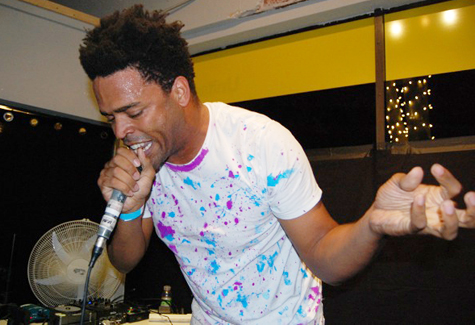
One Step Ahead
Busdriver
Friday, June 11, 2010
United State Boutique, Sacramento, CA
Busdriver introduced himself to his Sacramento faithful by stating his name and the fact that he “makes hip-hop the wrong way.” Immediately I began to wonder who this slight jab was directed toward, considering the door charge was $13, and he filled out the boutique rather well.
It depends on where you are raised on hip-hop, I guess. A graduate of South Central Los Angeles’ Project Blowed community, Busdriver is expected to be technically flawless and remarkable in his weirdness. Had he lacked these qualities, the faithful in that district would have politely asked him to “pass the mic” long ago. But eight albums deep (two of which were released on Epitaph) and touring schedules to foreign lands make it difficult to determine how he is incorrectly making hip-hop.
I will admit, I own zero Busdriver records and have often expressed befuddlement in the allure of his music–fast rap never did it for me. I learned about Busdriver the live performer years ago, though. It was an experience that altered my perception of his work. For the right price, I will attend a Busdriver show, as should any hip-hop connoisseur.
Aspiring rappers, aka the opening acts, take note of the level of expertise you must wield in order to rock a crowd bigger than your closest Facebook friends. Busdriver is easily one of the most compelling performers in the business, which is heightened by his lack of a posse or DJ. If Busdriver is on the bill, Busdriver is all you’ll see. One man with lungs like hot air balloons, bursting rhythmic tangents of tossed word salad–and somehow, his fans find enough connection to sing along. Sweet mercy, I saw people singing along, while local fledgling talent Chuuwee was in ear shot of me, wide-eyed and excited, telling his crew “I don’t know what he’s saying, but it’s hella fast.” Take notice, young pup.
I am comfortable with never comprehending the crossword puzzle of darts spewing forth from Busdriver’s mouth. His machine-gun delivery is the most impressive display of MCing I’ve seen in person. Sampling Mozart’s Sonata in A Major, “Me-Time… (With the Pulmonary Palimpsest)” was delivered with hairpin precision. Even if Busdriver faltered slightly, he casually filled the space with off-the-dome rhymes, until he regained his cue. I’ve witnessed some impressive Chicago MCs flex that ‘90s “do or die” style, rolling the Rs and bouncing to a “pibbitty-pibbitty” flow, but there’s a practiced routine employed. The chopping up of styles is a Project Blowed staple dating back before Freestyle Fellowship, but Busdriver is a master, while others are mere apprentices.
Most hip-hop heads, myself included, are still not ready for Busdriver. Although, judging by the audience–keying in on the all-ages element–traditional hip-hop heads were the minority that night. It would seem Busdriver is embraced by the young and the obnoxiously hip. Hip-hop is still in denial of its nerdier side–as if DJs weren’t the most reclusive oddballs ever–making Busdriver the talisman of art rap. Until being uncool replaces an undying obsession with being the most gangster, Busdriver will be sarcastically criticizing his art with jokes about “doing it wrong.” Although, those willing to open their minds to the complexities of his style shall be exposed to a format cursed to be called “ahead of its time” in the ensuing decades.
Mariachi Por Vida
The Bronx’s side project brings mariachi to the world
Words by Anthony Giannotti
Mariachi El Bronx is the mariachi side project of Los Angeles hardcore punk band The Bronx. No you don’t need to reread that. It’s not a typo. The Bronx, which is known for its hard-edged, balls-to-the-wall punk rock, has a traditional-style mariachi side project. It’s not unusual for a band to have side projects: The Green Day guys have Foxboro Hot Tubs, Jack White of The White Stripes has The Dead Weather, and Ben Gibbard of Death Cab for Cutie has The Postal Service. However, it is unusual and awesome when a band does a sideways double back flip into a completely different genre for a side project.
After having played many acoustic shows as The Bronx, Matt Caughthran, lead singer of both bands, explains how the band was looking for something different, “We always knew [The] Bronx was supposed to be fast, loud and in your face. We never liked playing stripped-down, just a singer and acoustic guitar. It’s not as fun… We were looking for something creative fun and lighter than full-blown hardcore.”
To combat the lackluster acoustic punk format, the band re-worked a few of their songs mariachi-style. From what I gather from the Spanglish conversations I’ve had with Mariachi musicians at Mexican restaurants, mariachi is a regional Mexican music. The lyrics have been influenced by the development of Mexico but mostly the lyrics are a bearing of the heart and soul of the Mexican people. Mariachi bands generally consist of violins, trumpets, an acoustic guitar, a guitarrón (a large acoustic bass), a high-pitched five-string guitar known as a vihuela and sometimes a harp. Musicians dress in silver studded suits known as traje de charro with wide-brimmed hats–a look that is quite the departure from a five-piece punk band. Mariachi El Bronx doesn’t disappoint on any of the aesthetics. They are a full band dressed in full charro gear. Even going as far as including bongo drums, ukulele, accordion, a smaller, higher-pitched guitar called requinto, not to mention the standard mariachi instrumentation to get the right Latin flavor to all the songs.
After having smashing success playing the rejuvenated songs at a few local L.A. shows, the side project snowballed into its own full-fledged creative outlet. “We just followed the music down the rabbit hole; so to speak. It was a part of us that we didn’t realize was there.” Caughthran says with a great deal of inspiration in his voice. He talks loosely about writing some of the songs on the Mariachi El Bronx album, “It was a natural progression and very liberating. It freed up an entire new creative avenue.”
Caughthran’s enthusiasm about the creative process is undeniable. You can feel the excitement in his tone. He continues to speak about the complex process The Bronx went through reinventing their music by saying, “Some days we wrote two even three songs, lyrics and all. It was one of the funnest albums we’ve recorded, because it went so smooth and easy.”
According to Caughthran, The Bronx never thought anything would actually come of the new project, or that they would record an album–let alone tour the world on its merits.
The mention of touring the world brings up an interesting subject. Any Californian knows that mariachi is abundant in this state; and if you’ve ever been to any of the other states that border Mexico, you know they have even larger mariachi scenes. But what about the rest of the country? “We were worried that people outside of California wouldn’t get the music,” Caughthran says. “Especially in Canada and Europe, they don’t have hardly any Latin influences there. But it’s been quite a relief and surprise. People are diggin’ it ‘cause it’s different!”
When I ask Caughthran if a mariachi traditionalist has ever been offended that a bunch of white guys were playing mariachi and singing it in English, he artfully sidesteps my question. “I mean, being from Los Angeles and, you know, growing up and surrounded by Mexican culture, it just kind of happened,” he laughs. “We can’t help it. We are Southern California boys, and we love mariachi.”
Thankfully for Caughthran and the boys, they have had very positive reception everywhere they have been. “This band has been so great,” he says. “Everyone has been so constructive. We have had so many doors opened that The Bronx would have never been able to do.”
The first big door was opened last summer when the boys got to play main support on a stadium tour with The Killers. “Those guys where so great,” he says. “They put us in venues we’d have never been in.” He even has some kind words about Sacramento. “I remember playing Sacramento on that tour, I think the place is called ARCO? Anyway, that crowd was one of the best on the tour. You could feel the love and support.” They also had the honor of touring Europe and the United Kingdom with the gypsy punks Gogol Bordello. Most interesting, they had the chance to tour with themselves–Mariachi El Bronx opened for The Bronx. Matt says, “That was one of the greatest, most grueling tours we have ever done. Playing twice in a night doesn’t sound that hard but it thoroughly drained us.” Putting forth the energy, let alone the emotion, to play two sets every night for an entire United States and European tour will put the hurt on anyone. “It was very rewarding to see all the people get into two very different types of music at one show,” he says. “The crowds put out the energy that recharged us for the second set.”
Mariachi El Bronx has some exciting stuff coming up, including a small California tour with Primus in September, according to Caughthran. After two shows in L.A., they’ll play Sacramento on Sept. 14. Matt explains they didn’t want to tour too much this fall, because they are in the process of recording the fourth Bronx album and second Mariachi El Bronx album, with the hope to release them as a double album next spring. With two new albums coming out and as much fan support as any band or bands could ask for, it seems The Bronx has this side project thing figured out pretty well. With their irrefutable lust for music, it’s certain we will be hearing more about Mariachi El Bronx in the near future.
Wild at Heart
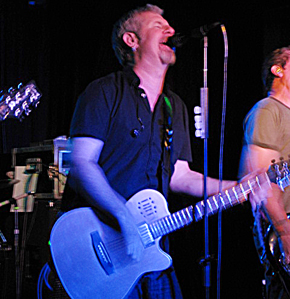
Young Dubliners
Thursday, June 3, 2010 – Harlow’s – Sacramento
Words & Photos by Anthony Giannotti
What’s the first thing that comes to mind when you hear the term Celtic rock? Hopefully not U2, maybe Flogging Molly, but more accurately you should think of Young Dubliners. After all, they are one of the most influential Celtic rock bands from the United States. After five years of skipping over the Sacramento area on tour, the Southern California-based Irishmen brought their flavor of traditional Irish folk and modern rock to Harlow’s night club Thursday night.
I had the privilege of witnessing it first-hand. After arriving a few minutes late and getting over the shock of a large portion of the crowd looking about the right age to have gone to high school with Betty White, I found the merrymaking in full swing. To fully appreciate the pub-like Irish folk, instrumental jam the Young Dubliners had broken into, I ordered a shot of Jameson with a Guinness back from the more than obliging bartender. Watching local Irish rockers BlackEyed Dempseys jump and bounce on the dance floor to the guitar-driven punk-inspired song “The Foggy Dew” set a mood that would make The Pogues proud.
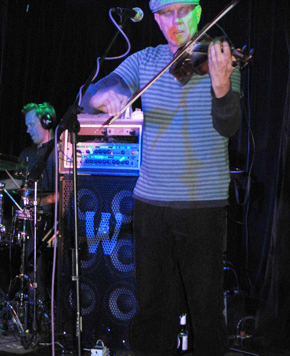
Young Dubliners lead singer Keith Roberts made the casual announcement that since the band hadn’t been to Sacramento in so long, they would be playing songs from all eight of their albums. Young Dubliners showed a softer side with a few heartfelt acoustic ballads such as “In the End.” A great deal of the lyrics off their new album, Saints and Sinners, speak out against how bad things have gotten internationally without losing the profound belief that things can and will get better. Traditional folk instrumental pieces such as “Ashley Falls” really allowed the well-seasoned musicians space to showcase their individual talents; specifically allowing fiddle player extraordinaire Chas Waltz some room to show off his chops. Not since Gilles Apap has such fine fiddle work been laid down; Waltz solos are a perfect blend of classical training and folk improvisation not to mention he plays in an intense Johnny Ramone-style power stance! Touring with the five-piece rock ‘n’ roll group was famed Uilleann pipe and pennywhistle master Eric Rigler. On some of the darker power ballads, he was able to make the already ominous bagpipes sound a little spookier with a slight delay on it. You might know Rigler for his work on such small movie soundtracks as Braveheart and Titanic. The accomplished piper treated the audience to the theme song from Braveheart, which I assume is the equivalent, for people of Celtic decent, as an American watching Jimmy Hendrix shred “The Star Spangled Banner” at Woodstock. Traditional Irish folk songs “Molly Malone” and “Seven Drunken Nights” really brought a bounty of dancers and hip shakers to the floor and ending the show with the Dropkick Murphys-ish power song “The Rocky Road to Dublin” set the small but enthusiastic crowd on fire.
After the great set and a few more Guinnesses I had a chance to chat with Keith Roberts. Through a barely decipherable Irish accent he first apologized for coming to Northern California and having allergies. After I apologized for arriving 15 minutes late, he assured me with a sly smile that those precious early minutes of the set were indeed the best part. Roberts did inform me that Young Dubliners planned on making Sacramento a regular stop on their touring schedule. “We are in the same freaking state for God’s sake,” he excitedly barked. Hopefully these words will hold true, because an evening spent with the Young Dubliners is an evening well spent. Make sure to catch their next Sacramento performance and you to will fully understand what Celtic rock means.

